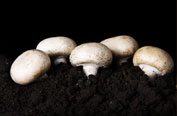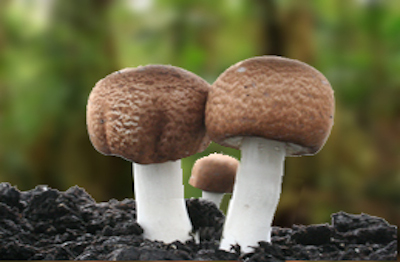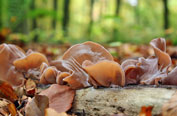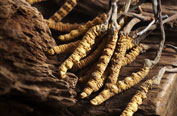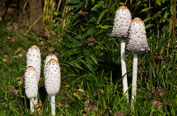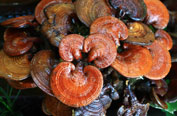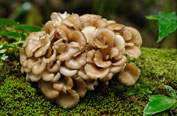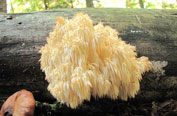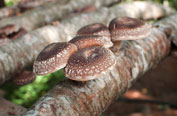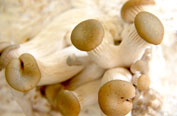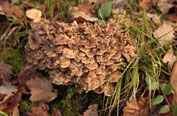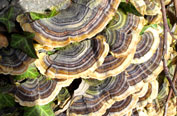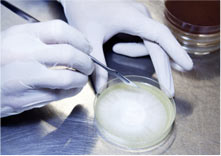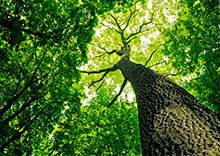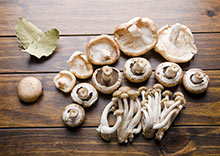
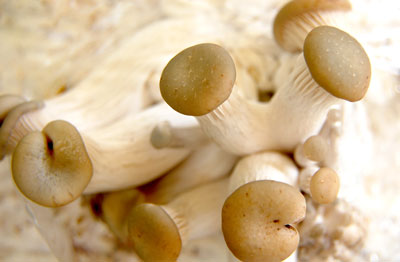
Allgemeines
-
Pleurotus ostreatus
Synonyme: Austernpilz, Austernseitling, Kalbfleischpilz, Hiratake, TamogitakeInhaltsstoffe: Pleuran, Lovastatin, Folsäure, Vitamine B, C und D
Traditionelle Anwendungsgebiete:
- Blutfettsenkung, Cholesterinkontrolle (1-13)
- Anti-Aging (14-19)
Pleurotus ostreatus ist bekannt als beta-Glucanquelle, für seine das Immunsystem stimulierende Wirkung und wird seinem Ruf als Anti-Aging-Mittel gerecht. Bei der Cholesterinkontrolle konnten in Tierversuchen verbesserte Blutfett- und Leberwerte festgestellt werden, und auch beim Menschen konnten die Cholesterinwerte von Diabetes-Patienten erheblich verbessert werden (sh. Pleurotus ostreatus (1-13)).
Neben seinen immunmodulierenden und krebshemmenden Eigenschaften sind die in Pleurotus ostreatus enthaltenen Polysaccharide im Hinblick auf ihren positiven Einfluss auf altersabhängigen Vitaminmangel äusserst interessant (sh. Pleurotus ostreatus (14-19)).
Über den Pilz:Verbreitung und Habitat in der Natur:
Hauptsächlich auf kranken sowie toten Laubbäumen, selten auf Nadelhölzern. Weit verbreitet auf der ganzen Welt.Verwendung:
Speisepilz, Vitalpilz
Der Austernpilz ist ein sehr einfach zu züchtender Speisepilz. Das Myzel dieses Pilzes ist sehr robust, weshalb er einer der beliebtesten Zuchtpilze ist. Die Fruchtkörper erreichen einen Durchmesser von 5 - 15 cm. Der Hut ist graubraun bis violett, nach unten hin zu den Lamellen und beim Stiel geht die Farbe ins Weißliche über. Pleurotus ist reich an Vitaminen des B-Komplexes wie u. a. B1 (Thiamin), B2 (Riboflavin), B5 (Niacin), B6 und B7 (Biotin). Darüber hinaus enthält er Folsäure sowie die Vitamine C und D (Calciferol). Ein Viertel der Trockensubstanz dieses Pilzes besteht aus Proteinen und enthält alle essentiellen Aminosäuren. Sehr wichtige Inhaltsstoffe des Pleurotus sind auch ß-Glukane (Polysaccharide), Pleuran und Lovastatin. Studien
-
Wissenschaftliche Studien über Pleurotus ostreatus
1) Effect of mushroom Pleurotus ostreatus and isolated fungal polysaccharide on serum and liver lipids in Syrian hamsters with hyperlipoproteinemia. Bobek P, Ginter E, Kuniak L, Babala J, Jurcovicova M, Ozdín L, Cerven J. Nutrition. 1991;7(2):105-8.2) Cholesterol-lowering effect of the mushroom Pleurotus ostreatus in hereditary hypercholesterolemic rats. Bobek P, Ginter E, Jurcovicová M, Kuniak L. Ann Nutr Metab. 1991;35(4):191-5.
3) Effect of oyster fungus (Pleurotus ostreatus) on serum and liver lipids of Syrian hamsters with a chronic alcohol intake. Bobek P, Ginter E, Jurcovicová M, Ozdín L, Mekinová D. Physiol Res. 1991;40(3):327-32.
4) Dose-dependent hypocholesterolaemic effect of oyster mushroom (Pleurotus ostreatus) in rats. Bobek P, Ozdín L, Kajaba I. Physiol Res. 1997;46(4):327-9.
5) Dose- and time-dependent hypocholesterolemic effect of oyster mushroom (Pleurotus ostreatus) in rats. Bobek P, Ozdín L, Galbavý S. Nutrition. 1998;14(3):282-6.
6) Hypocholesterolemic activity of the genus Pleurotus (Jacq.: Fr.) P. Kumm. (Agaricales s. I., Basidiomycetes) Nina Gunde-Cimerman et al, Int J Med Mushr 2001;3(4)
7) Evidence for the anti-hyperlipidaemic activity of the edible fungus Pleurotus ostreatus. Opletal L, Jahodár L, Chobot V, Zdanský P, Lukes J, Brátová M, Solichová D, Blunden G, Dacke C.G, Patel A.V. Br J Biomed Sci. 1997;54(4):240-3.
8) Dietary mushroom (Pleurotus ostreatus) ameliorates atherogenic lipid in hypercholesterolaemic rats. Hossain S, Hashimoto M, Choudhury E.K, Alam N, Hussain S, Hasan M, Choudhury S.K, Mahmud I. Clin Exp Pharmacol Physiol. 2003;30(7):470-5.
9) Role of oyster mushroom (Pleurotus florida) as hypocholesterolemic/antiatherogenic agent. Bajaj M, Vadhera S, Brar A.P, Soni G.L. Indian J Exp Biol. 1997;35(10):1070-5.
10) Cholesterol-lowering effect of Pleurotus species (Agaricomycetideae) (Abstracts of papers published in 1991-1999) Bobek P. Int J Med Mushr. 1999;1(4):371-380
11) A lectin from the edible and medicinal mushroom Pleurotus ostreatus (Jacq.: Fr.) Kumm. as a food intake suppressing substance. Yokoyama S, Nakamura H, Tokuyama S. Int J Med Mush. 2001;3(2-3)
12) Antihyperlipidemic effect of Pleurotus ostreatus in HIV: results of a pilot proof-of-principle clinical trial. Abrams D.I, Couey P, Shade S.B, Kelly M.E, Kamanu-Elias N, Stamets P.E. Int J Med Mushr. 2007;9(3):204
13) Oyster mushroom reduced blood glucose and cholesterol in diabetic subjects. Khatun K, et al Mymensingh Med J. 2007;16(1):94-9
14) Effect of oyster mushroom (Pleurotus ostreatus) on pathological changes in dimethylhydrazine-induced rat colon cancer. Bobek P, Galbavy S, Ozdin L. Oncol Rep. 1998;5(3):727-30.
15) Cytotoxic effect of oyster mushroom Pleurotus ostreatus on human Androgen-independent prostate cancer PC-3 cell. Gu Y.H, Sivam G. J Med Food. 2006;9(2):196-204
16) Effects of Lentinus edodes, Grifola frondosa and Pleurotus ostreatus administration on cancer outbreak and activities of macrophages and lymphocytes in mice treated with a carcinogen N-butyl-N-butnolnitrosamine. Kurashige S, Aleusawa Y, Endo F. Immunopharm. Immunodetox. 1997;19:175-183.
17) Antioxidant activity of the oyster mushroom, Pleurotus ostreatus, on CCl(4)-induced liver injury in rats. Jayakumar T, Ramesh E, Geraldine P. Food Chem Toxicol. 2006;44(12):1989-96.
18) Protective effect of an extract of the oyster mushroom, Pleurotus ostreatus, on antioxidants of major organs of aged rats. Jayakumar T et al. Exp Gerontol. 2007;42(3):183-91.
19) An extract of the oyster mushroom, Pleurotus ostreatus, increases catalase gene expression and reduces protein oxidation during aging in rats. Thanasekaran J, Aloysius P.T, Mathivanan I, Pitchairaj G.J. Chin Int Med. 2010;8(8):774-780
Taxonomie
-
Taxonomie
Klasse: Agaricomycetes
Unterklasse: Agaricomycetidae
Ordnung: Champignonartige (Agaricales)
Familie: Seitlingsverwandte (Pleurotaceae)
Gattung: Seitlinge (Pleurotus)
Art: Pleurotus ostreatusSporen: meist weiß bis grau, 7,5 - 9,5 x 3 - 4 µ, Schnallen sind vorhanden (clamp connections) Zuchtbedingungen
-
Zuchtbedingungen
Phase 1: Mycelwachstum
Temperatur: 24°C
Luftfeuchte: 85 - 95%
Dauer: 12 - 21 Tage
CO2: 5,000 - 20,000 ppm
Raumluftwechsel: 1 pro Stunde
Licht: n/a
Phase 2: Aufstellen der Myzelien / Einleitung der Fruchtung
Temperatur: 10 - 15,6°C
Luftfeuchte: 95 - 100%
Dauer: 3 - 5 Tage
CO2: <1,000 ppm
Raumluftwechsel: 4 - 8 pro Stunde
Licht: 1,000 - 1,500 (2,000) Lux
Phase: Fruchtung und Ernte
Temperatur: 10 - 21°C
Luftfeuchte: 85 - 90%
Dauer: 4 - 7 Tage
CO2: <1,000 ppm
Raumluftwechsel: 4 - 8 pro Stunde
Licht: 1,000 - 1,500 (2,000) Lux
Erntewellen: Alle 7 - 14 Tage für 45 -55 Tage
Geeignetes Substrat:
Stroh, Papier, Kaffeesatz, Fruchtfleisch von Kaffeebohnen, Laubholz (Pappel, Eiche, Erle, Espe, Ahorn, Birke, Esche, Buche, Weide, Ulme)

